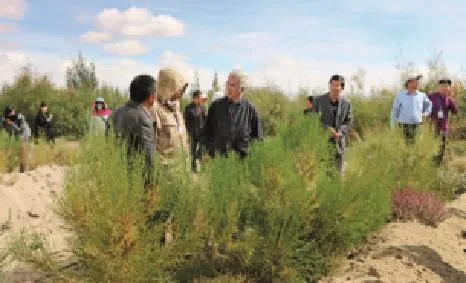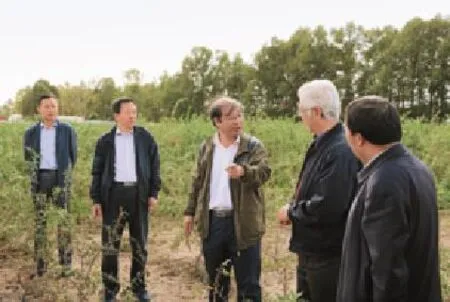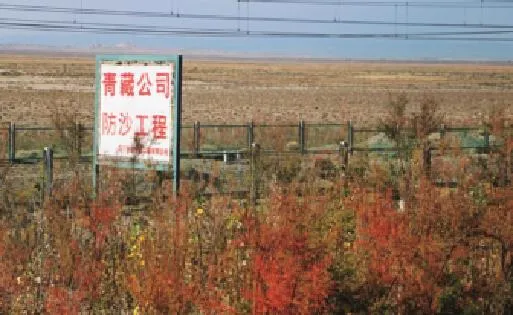Developing Eco-industry to Curb Desertifcation
By CHEN XIN
Developing Eco-industry to Curb Desertifcation
By CHEN XIN

An Fengjie (third left), inspector with the Department of Rural Forestry Reform and Development, State Forestry Administration of China, inspects a cistanche planting base in Haixi. An is also director of China National Sand Control and Desert lndustry Society.

The head of a goji berry planting base introduces plant breeding to experts attending the desertifcation prevention and control seminar in September.
DESERTIFICATION, one of the most serious ecological issues facing the world, is regarded as key in China’s ecological restoration, but is a knotty problem. Desertifcation has devoured space that could otherwise be used to improve people’s standard of living.
On a national scale, desertification is a barrier in the way of bringing moderate prosperity to the country and damaging the sustainable development of the economy and society. Therefore, controlling desertification and improving the ecological system, especially in the desert area, is now a top priority.
From September 24 to 26, 2016 the China Haixi Desertification Prevention and Control and Green Ecological Industrial Development Seminar was held in Delingha City, Haixi Prefecture of Qinghai Province. After on-site inspections and discussions, the participating experts fully affirmed Haixi’s practices in preventing desertifcation and developing “sand industry.” They believed the Chinese goji berry industry in Haixi was a great model of China’s desertifcation management, combining sand control, poverty reduction, and ecological restoration.
Haixi Mongolian and Tibetan Autonomous Prefecture is located in the northeastern part of the Qinghai-Tibet Plateau. Its 320,000-square-kilometer area accounts for 44.4 percent of the Qinghai Province. However, this includes 76 percent of the desert land of the province, or 29.6 percent of provincial territory.
In recent years Haixi has upheld the tenet of equal emphasis on environmental and economic progresses. The government engages in building a comprehensive ecological rehabilitation system that deals with environmental protection and economic development in a balanced way. It has closed hillsides for forest conservation and reforestation, carried out projects to fix sand dunes, and the goji berry planting and related industries in Qaidam Basin are an important part of its efforts.
Qaidam is located in the center of the Qinghai-Tibet Plateau that is claimed to be one of the world’s four super clean areas. Under a plateau continental climate, the basin is dry and enjoys strong sunlight, vast temperature variations between day and night, and abundant surface water and groundwater resources.
In addition, the arable land in the Qaidam Basin is gray-brown desert soil, a kind of sandy loam, which is the best soil for growing goji berries because it has the optimum pH value and containscomponents such as ammonia, phosphorus, potassium, and organic matter. These natural conditions are good for the formation of organic substances and effective constituents in the fruit.
One more credit is the cold, dry weather in Haixi that prevents the fruit from being overrun by pests and diseases. The goji berry planting area is far away from the cities so the plants grow in an environment free of polluted water and soil, which ensures organic and healthy fruit.
Thanks to these climate and geographical conditions, the goji berries produced in Qaidam Basin are bigger and brighter in color, and have a higher nutritional value and effective constituents compared with those cultivated in other areas. In recent years, the CPC prefectural committee and the government of Haixi have been striving to develop green, ecological industries, the most successful of which have been the goji berry and cistanche grafted on sacsaoul.
Currently, the area of goji berry cultivation stands at 500,000 mu (15 mu=1 hectare), including 70,000 mu across two standardized organic planting bases, 30,000 mu of which meeting the organic standards of the European and the U.S. markets. Haixi Prefecture has formulated two local standards for goji berry planting, which guide the operation of over 30 production lines that produce up to 50 varieties of products.
A complete industrial chain has been formed in Haixi from planting, processing, technology research and development to sales. As China’s second largest goji berry producing area, Haixi is listed among the seventh group of national agricultural standardization demonstration areas. Its yearly output of goji berry reaches 60,000 tons, with a comprehensive value of RMB 6 billion. The average annual export volume floats between 800 and 900 tons, bringing about a revenue of US $10.79 million.
Haixi so far has over 1,400 companies, cooperatives, and contractors of different sizes, engaging in goji berry planting and processing. They involve 8,361 rural households, each of whom can earn more than RMB 6,000 every year in the sector. More than 70,000 workers in the planting bases realize a total of service income of over RMB 500 million by gathering goji berry fruits.
In addition, the Haixi prefectural government has also encouraged farmers to breed livestock in the goji berry forests. In 2015, there were 20,300 goats and 72,000 chickens roaming in Haixi’s goji berry woods and harvested Chinese goji honey totaled 140 tons. The area for planting cistanche also amounted to 10,000 mu in the prefecture.

The desertifcation control project along the Qinghai-Tibet Railway.
Developing ecological industries such as planting Chinese goji berry and medicinal herbs has brought about economic benefts for local farmers and herders, and prevented and controlled desertification. The goji berry forests serve as a natural shield for the ecological system, and work well for sand fxation.
The small goji fruit has turned the former desert into an oasis, enabling the villagers to live a better life. It has been proved to be an effective way to turn ecological management into a viable business and an extra source of income for the people.
Liu Shu is the former vice-chairman of the China Association for Science and Technology, a senior consultant for the UNEP desertification department, and a member of a senior expert panel on China’s anti-desertification project. Liu said that the sand industry, which was the core of the sixth industrial revolution put forward by respectable scientist Qian Xuesen, refers to creating an industrial cluster that integrates agriculture, industry, and trade, on the basis of a deep understanding of deserts and the Gobi in particular, as well as the application of modern technology and the concept of circular economy. The goji berry industry in Haixi, in fact, is the best example of the so-called sixth industrial revolution, which leads the country in managing and controlling desertifcation and developing green industry.
At the 2016 China Haixi Desertification Prevention and Control and Green Ecological Industrial Development Seminar local offcials and technicians showcased new forestry technologies to plant trees and bushes to resist desertifcation and drought, and formed a prefecturecounty-township three-tier technology extension system.
Haixi has fxed the sands in an area of more than 1.3 million mu by afforestation, closing hillsides for reforestation, and sand fxation projects. A total of 20 million mu of ecological forests is under key protection. The forest coverage rate now stands at 3.5 percent in the prefecture. At the same time, green fences have been added along the Qinghai-Tibet Railway and National Highway 315 in Delingha, the forefront city of the flowing sands. The fences have formed a green corridor that creates an unusual sight in the desert and protects transportation.

